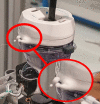The influence of prolonged instrument manipulation on gas leakage through trocars
- PMID: 37442835
- PMCID: PMC10462547
- DOI: 10.1007/s00464-023-10240-5
The influence of prolonged instrument manipulation on gas leakage through trocars
Abstract
Background: During laparoscopic surgery, CO2 insufflation gas could leak from the intra-abdominal cavity into the operating theater. Medical staff could therefore be exposed to hazardous substances present in leaked gas. Although previous studies have shown that leakage through trocars is a contributing factor, trocar performance over longer periods remains unclear. This study investigates the influence of prolonged instrument manipulation on gas leakage through trocars.
Methods: Twenty-five trocars with diameters ranging from 10 to 15 mm were included in the study. An experimental model was developed to facilitate instrument manipulation in a trocar under loading. The trocar was mounted to a custom airtight container insufflated with CO2 to a pressure of 15 mmHg, similar to clinical practice. A linear stage was used for prolonged instrument manipulation. At the same time, a fixed load was applied radially to the trocar cannula to mimic the reaction force of the abdominal wall. Gas leakage was measured before, after, and during instrument manipulation.
Results: After instrument manipulation, leakage rates per trocar varied between 0.0 and 5.58 L/min. No large differences were found between leakage rates before and after prolonged manipulation in static and dynamic measurements. However, the prolonged instrument manipulation did cause visible damage to two trocars and revealed unintended leakage pathways in others that can be related to production flaws.
Conclusion: Prolonged instrument manipulation did not increase gas leakage rates through trocars, despite damage to some individual trocars. Nevertheless, gas leakage through trocars occurs and is caused by different trocar-specific mechanisms and design issues.
Keywords: Laparoscopic model; Trocar leakage; Trocar manipulation.
© 2023. The Author(s).
Conflict of interest statement
Mr Daniel Robertson, Mr Matthijs van Duijn, Dr Alberto Arezzo, Dr Yoav Mintz, and Dr Tim Horeman-Franse have no conflicts of interest or financial ties to disclose.
Figures








Similar articles
-
Characterisation of trocar associated gas leaks during laparoscopic surgery.Surg Endosc. 2022 Jun;36(6):4542-4551. doi: 10.1007/s00464-021-08807-1. Epub 2021 Nov 3. Surg Endosc. 2022. PMID: 34731302 Free PMC article.
-
Escape of surgical smoke particles, comparing conventional and valveless trocar systems.Surg Endosc. 2023 Nov;37(11):8552-8561. doi: 10.1007/s00464-023-10444-9. Epub 2023 Oct 4. Surg Endosc. 2023. PMID: 37794124 Free PMC article.
-
Variables in the spread of tumor cells to trocars and port sites during operative laparoscopy.Surg Endosc. 2002 Oct;16(10):1413-9. doi: 10.1007/s00464-001-9112-8. Epub 2002 Jun 4. Surg Endosc. 2002. PMID: 12042907
-
Laparoscopic entry: a review of techniques, technologies, and complications.J Obstet Gynaecol Can. 2007 May;29(5):433-447. doi: 10.1016/S1701-2163(16)35496-2. J Obstet Gynaecol Can. 2007. PMID: 17493376 Review. English, French.
-
Does closure of fascia, type, and location of trocar influence occurrence of port site hernias? A literature review.Surg Endosc. 2020 Dec;34(12):5250-5258. doi: 10.1007/s00464-020-07826-8. Epub 2020 Jul 29. Surg Endosc. 2020. PMID: 32728766 Review.
Cited by
-
Clear Vision, Clear Savings: Enhancing Efficiency in Minimally Invasive Surgery.JSLS. 2025 Jul-Sep;29(3):e2025.00023. doi: 10.4293/JSLS.2025.00023. Epub 2025 Jul 14. JSLS. 2025. PMID: 40666161 Free PMC article.
References
-
- Robertson D, Sterke F, van Weteringen W, Arezzo A, Mintz Y, Nickel F, Boni L, Baldari L, Carus T, Chand M, Fuchs H, Ficuciello F, Marconi S, Mylonas G, Kim YW, Nakajima K, Schijven M, Valdastri P, Sagiv C, Mascagni P, Myśliwiec P, Petz W, Sánchez-Margallo F, Horeman T. Characterisation of trocar associated gas leaks during laparoscopic surgery. Surg Endosc. 2022;36:4542–4551. doi: 10.1007/s00464-021-08807-1. - DOI - PMC - PubMed

